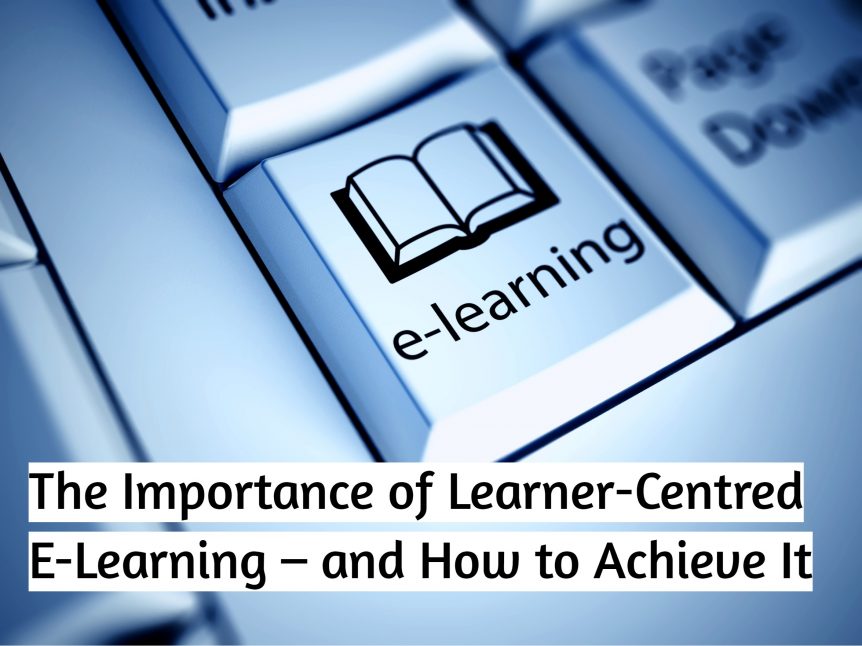The Importance of Learner-Centred E-Learning – and How to Achieve It
Creating e-learning courses and modules for learners sounds like stating the obvious. Why wouldn’t all your training elements, including e-learning modules, be learner-centred?
It’s not as simple as that in the real world, however. Individuals have their own pressures in the workplace, not least time pressures. This applies to those responsible for training as much as anyone else.
The business itself has priorities too, from compliance issues to achieving targets to remaining competitive in increasingly challenging environments.
Then there are the subject-matter experts who contribute essential parts of the content that is included in your e-learning courses. For them, more often than not, content is king.
As a result, trainer-centred, company-centred, and/or content-centred too often trumps learner-centred.
A Learner-Centred Approach
Taking a learner-centred approach, however, will deliver substantially better results.
Learners will grasp the topics being covered more easily and quickly, they will retain the information better, and you will see better results in desired behavioural change.
How do you achieve this, though? More guidance and tips are below, but it is also beneficial to use a professional e-learning developer in Dubai. Outside professionals are not as close to the people involved or the subject area so they can take the necessary steps required to see the topic from the perspective of learners.
This is essential in the development of learner-centred e-learning – or any other type of training, for that matter.
Developing Learner-Centred E-Learning – Planning Is Essential
When developing learner-centred e-learning, everything starts with planning. In the planning stage, there are two key questions you need to answer:
- Who are the learners who will complete the e-learning course?
- What do you want to achieve by developing the course?
In terms of the first question, look at as many factors as possible to get a proper understanding. Some examples include:
- Where are the learners located?
- What are their job roles?
- Will their job role impact their experience of the content?
- What level of knowledge or skill do they currently have in the subject area?
- Is this level of knowledge and skill relatively uniform or is there substantial variation?
- What is the general attitude to training?
- What challenges will learners face completing the course, understanding the topic, implementing what they have learned, etc
In relation to defining what you want to achieve, be as specific as possible with your answer. For example, you might want sales to increase as a result of the training, or you might want to see significant changes in behaviour.
Key Characteristics of Learner-Centred E-Learning
What does learner-centred e-learning look like and how does it differ from other types of training courses? Here are some key characteristics of learner-centred e-learning that you should aim to include in your courses.
Interactive
Training courses that are not learner-centred involve telling the learner or giving the learner information. Most of the time, the learner is a passive participant. This applies whether the training is delivered using e-learning or another method
In learner-centred e-learning, however, the learner is an active participant. To achieve this, you should include as many interactive elements in your e-learning course as possible.
Challenging
All too often, training courses are about going through the motions. For the company involved, it’s going through the motions to put a tick in a box, often in relation to compliance. For learners, it’s about going through the motions because their employer has told them to.
This is not learner-centred training, however.
Learner-centred training and e-learning should be challenging for the learner and should get them out of their comfort zone as much as possible.
Tone Should Be Friendly and Inclusive
One of the easiest ways to spot an e-learning course that is not learner-centred is to look at the language used. A third-party voice and language that is stuffy and formal are not learner centred. These features produce an overall tone that distances the learner from the topic and the course, benefiting nobody.
The better approach is to use language that is professional but that is also welcoming, conversational, and inclusive. It’s important to talk with the learner, not at them.
Relatable
Don’t cover topics in the abstract or use examples, stories, or scenarios that learners will find it difficult to relate too.
Learner-centred e-learning includes features (those above as well as images, branding, and design) that the learner can relate to.
For example, when creating a scenario, use a scene that reflects a real-life situation that could realistically happen in your company.
Empowering
Another key characteristic of learner-centred e-learning is the fact it empowers learners. In other words, it gives learners a say over their development as well as their progress through the training.
You can use adaptive learning techniques to achieve this, for example, or just in time learning.
By empowering learners, whatever techniques you use, the central focus will be on them.
Top Tips
Finally, here are two additional tips that can help you make your e-learning courses more learner-centred.
The first is to spend time explaining to learners how they will benefit from completing the training. Don’t just frame the training around the needs of the business. Look at it from the perspective of learners too.
Secondly, collaboration is a key part of many learner-centred e-learning courses. Therefore, include collaborative elements when applicable.
There doesn’t need to be a massive transition to focus efforts on creating learner-centred e-learning. By doing so, however, overall results will improve, including return on investment.

